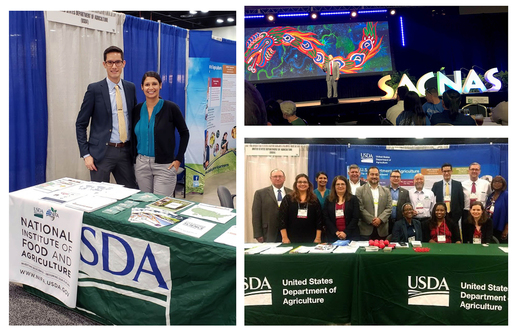 2nd State of the Carbon Cycle Report
The U.S. Global Change Research Program (USGCRP) released the Second State of the Carbon Cycle Report (SOCCR2) on Nov. 23. The report assesses the last decade of carbon cycle advances across the United States, Canada, and Mexico. USDA served as the federal administrative lead for this USGCRP Sustained Assessment Report.
Information given in this scientific assessment relates to carbon research as well as management practices in North America and around the world. The balance of carbon emissions (sources), uptake (sinks), and transformations is relevant to society, food and fiber production, many livelihoods, and to climate change and other environmental factors. The report synthesizes the latest understanding of carbon sources and sinks since the last state of the carbon cycle report a decade ago, as well as the causes, interactions, and exchanges of carbon across North America. With over 200 contributing authors, SOCCR2 contains many scientifically significant and societally relevant key findings. Download SOCCR2 report to learn more.
|
NIFA at SACNAS
 Dr. Carlos Ortiz, program specialist with the Division of Community and Education, (left) and Dr. Karelyn Cruz, national program leader with the Division of Environmental Systems, represented NIFA at the 2018 Society for the Advancement of Chicanos/Hispanics and Native Americans in Science (SACNAS) annual conference. SACNAS markets their conference as “The National Diversity in STEM Conference” with three days full of science, professional development, training, and mentoring for students and professionals at all levels.
This year, over 4,200 attendees met in San Antonio, Texas. At the career fair, over 400 students stopped by the One Team USDA booths (NIFA, ARS, ERS, APHIS, NASS, and NRCS) to learn about agency programs. NIFA staff also give a talk on NIFA-funded programs at an agricultural microbiome session.
 I Won't Turn another Clod
Plunging his shovel into a wheat field covered in soybean residue, Gary Hula hefts up a mound of crumbly soil with a grin. The county is under moderate drought and it’s just above freezing outside, but the soil in his shovel is full of moisture and riddled with worm holes—sure signs of healthy soil. It’s been more than 12 years since Pond Creek was listed as an impaired waterbody, and it’s not just the soils that are unrecognizable. Working with their local NRCS conservation planner and the Grant County Conservation District, farmers like Hula—throughout the Pond Creek watershed—are adopting conservation practices that improve water quality. Read the full USDA blog article.
After witnessing the benefits of no-till to farming and wildlife, Gary Hula is committed to “never turning another clod.” Photo by Robert Hathorne, NRCS.
|
 USDA Invests in Rural Facilities That Will Benefit More Than 761,000 Americans
Anne Hazlett, Assistant to the Secretary for Rural Development, announced that USDA is investing $291 million to build or improve community infrastructure and essential services for 761,000 residents in 18 states and the Commonwealth of Puerto Rico. “Modern community facilities and infrastructure are key drivers of rural prosperity,” Hazlett said. “As partners to municipal, tribal, and nonprofit leaders, we are investing in rural communities to ensure quality of life and economic opportunity now and for generations to come.” Read the full USDA press release.
|
 NIFA Grant Opportunities. Check out the funding opportunities available through NIFA. The NIFA website contains a complete online listing of grant opportunities available. If you see an opportunity you're interested in, call or email the program contact to learn more.
|
Rural Health and Safety Education: Combating Opioids
Purdue University is hosting the Rural Health and Safety Education webinar series "Combating Opioids" Dec. 7 at 2 p.m. EST. To register, log in as a "Guest" (type your first and last name) and "enter room."
|